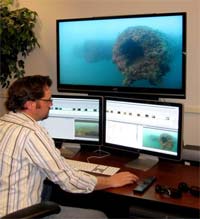National Park Service Delivering 3D Underwater Imagery to Students
- By Dian Schaffhauser
- 04/20/10

Brett Seymour, underwater photographer and production coordinator for the NPS Submerged Resources Center |
Camera and monitor company JVC is playing a role in bringing 3D footage to classrooms. The company's Professional Products division is working with the Denver-based National Park Service Submerged Resources Center (SRC) to create underwater 3D recordings through a partnership with the Advanced Imaging and Visualization Laboratory (AIVL) at the Woods Hole Oceanographic Institution in Woods Hole, MA. SRC performs inventory and evaluation of submerged resources, such as shipwrecks, in the National Park System. The Woods Hole institution performs research and education about the ocean. AIVL is a division of the institution that specializes in underwater imaging.
Currently, the SRC is working with the AIVL on three projects. Shooting has been completed on "Alien Invaders," which looks at invasive underwater species found in Lake Mead National Recreation Area in Clark County, NV. The video, currently in post, is designed to fit fifth and sixth grade science curricula for Nevada. Another video provides underwater 3D HD footage of the USS Arizona Memorial in Honolulu. That will go into post-production this summer. A third project offers a sample of the underwater wonders in national parks. The main video will feature several parks, but the SRC will also produce park-specific 3D presentations for visitor centers. Shooting is scheduled to continue over the next seven months. Those are expected to be done in time for fall 2011 release.
The AIVL has a set of 3D camera rigs for in-air and underwater use--most using dual Sony SRW-1 HD portable digital video recorders to record the content. The lab also owns several GD-463D10U 46-inch 3D LCD high-definition monitors that are used for mobile presentations and internally for reviewing footage. This particular display has an integrated Xpol polarizing filter, which consists of micro-polarizers arranged in a precise array and applied to the surface of a flat-panel display. Viewers use polarized glasses to view flicker-free 3D HD images. The monitor also allows the AIVL to review its footage in real time without going through a computer system.
"We wanted to have a large passive display for reviewing 3D imagery and also for 3D presentations on the road," said William Lange, AIVL research specialist. "The monitor had the capability to work with existing 3D infrastructure that we had. It's become an easy way for us to do field presentations as well."
SRC is also using the JVC displays. Students love 3D content because it engages them, said Brett Seymour, an AV production specialist with the Park Service. "3D also provides a 'wow' factor, which is great," he said but added that the SRC avoids 3D gimmicks in its videos. "We are using 3D to bring a new dimension to the underwater world of the National Park Service." He said the center would eventually design and distribute its own branded paper 3D glasses, which will provide students with a "souvenir" of the experience.
The JVC monitors are shipped and displayed in cases designed by Jelco, which specializes in making gear mobile. Seymour said this combination has allowed the SRC to share its 3D video footage at conferences, diving trade shows, and classrooms.
The SRC owns three of the 3D monitors, and Seymour anticipates the agency will purchase another three units in the next year. One of those stays in his edit bay for playback of 2D and 3D content, and the mobile units are often used to display PowerPoint and other 2D materials during presentations.
About the Author
Dian Schaffhauser is a former senior contributing editor for 1105 Media's education publications THE Journal, Campus Technology and Spaces4Learning.